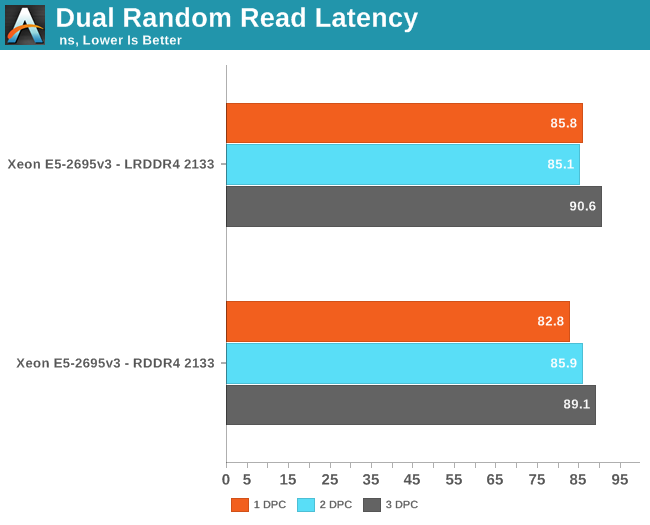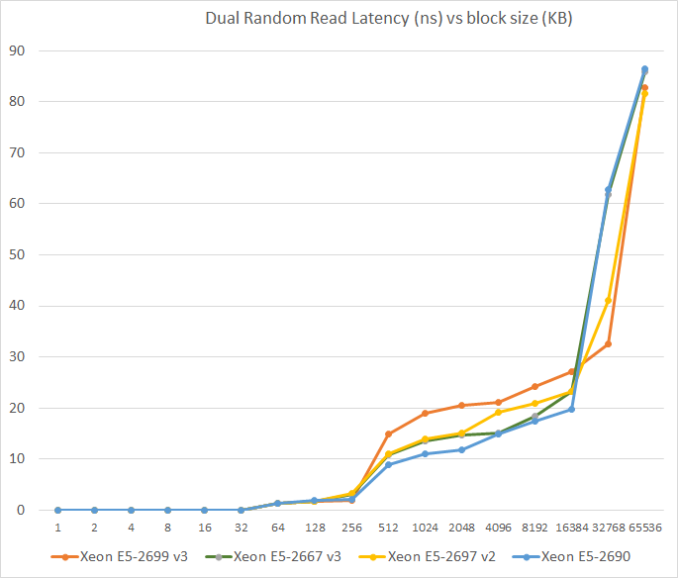Intel Xeon E5 Version 3: Up to 18 Haswell EP Cores
by Johan De Gelas on September 8, 2014 12:30 PM ESTMemory Subsystem: Latency
To measure latency, we use the open source TinyMemBench benchmark. The source was compiled for x86 with gcc 4.8.2 and optimization was set to "-O2". The measurement is described well by the manual of TinyMemBench:
Average time is measured for random memory accesses in the buffers of different sizes. The larger the buffer, the more significant the relative contributions of TLB, L1/L2 cache misses, and DRAM accesses become. All the numbers represent extra time, which needs to be added to L1 cache latency (4 cycles).
We tested with dual random read, as we wanted to see how the memory system coped with multiple read requests. To keep the graph readeable we limited ourselves to the CPUs that were different. The Xeon E5-2695 and 2699 have a very similar memory subsytem (dual memory controller) so we tested only the E5-2699.
The massive L3 caches do have some disadvantages: latency goes up. The L3 cache of the Xeon E5-2699 v3 (45MB) has a latency between 20 and 32 ns while the 20MB cache of the Xeon E5-2690 hovers between 15 and 20 ns. That translates to about 90 cycles versus 60, which is considerable. However, it's not a case of the Haswell's L3 cache being a lot worse: the 20MB L3 cache of the Xeon E5-2667 v3 is only slightly slower than the Xeon E5-2690 and is still faster than the Xeon E5-2697 v2 (30MB). The main culprit is simply dealing with a huge amount of cache on the E5-2699 v3. In the next test, we will focus on the latency of the DRAM subsystem.

The DRAM subsystem is still three or four times slower than the massive L3 cache. LRDIMMs still have a very small latency overhead – +3.6% at the most – but that is neglible.
DDR4-2133 seems to have the same latency as DDR3-1866 . We measured 81.6 ns on the Xeon E5-2697 v2. Considering that DDR4-2400 is just around the corner, DDR4 will quickly give a performance boost to the new platform.











85 Comments
View All Comments
MorinMoss - Friday, August 9, 2019 - link
Hello from 2019.AMD has a LOT of ground to make up but it's a new world and a new race
https://www.anandtech.com/show/14605/the-and-ryzen...
Kevin G - Monday, September 8, 2014 - link
As an owner of a dual Opteron 6376 system, I shudder at how far behind that platform is. Then I look down and see that I have both of my kidneys as I didn't need to sell one for a pair of Xeons so I don't feel so bad. For the price of one E5-2660v3 I was able to pick up two Opteron 6376's.wallysb01 - Monday, September 8, 2014 - link
But the rest of the system cost is about the same. So you get 1/2 the performance for a 10% discount. YEPPY!Kevin G - Monday, September 8, 2014 - link
Nope. Build price after all the upgrades over the course of two years is some where around $3600 USD. The two Opterons accounted for a bit more than a third of that price. Not bad for 32 cores and 128 GB of memory. Even with Haswell-E being twice as fast, I'd have to spend nearly twice as much (CPU's cost twice as much as does DDR4 compared to when I bought my DDR3 memory). To put it into prespective, a single Xeon E5 2999v3 might be faster than my build but I was able to build an entire system for less than the price Intel's flagship server CPU.I will say something odd - component prices have increased since I purchased parts. RAM prices have gone up by 50% and the motherboard I use has seemingly increased in price by $100 due to scarcity. Enthusiast video card prices have also gotten crazy over the past couple of years so a high end video card is $100 more for top of the line in the consumer space.
wallysb01 - Tuesday, September 9, 2014 - link
Going to the E5 2699 isn’t needed. A pair of 2660 v3s is probably going to be nearly 2x as fast the 6376, especially for floating point where your 32 cores are more like 16 cores or for jobs that can’t use very many threads. True a pair of 2660s will be twice as expensive. On a total system it would add about $1.5K. We’ll have to wait for the workstation slanted view, but for an extra $1.5K, you’d probably have a workstation that’s much better at most tasks.Kevin G - Friday, September 12, 2014 - link
Actually if you're aiming to double the performance of a dual Opteron 6376, two E5-2695v3's look to be a good pick for that target according to this review. A pair of those will set you pack $4848 which is more than what my complete system build cost.Processors are only one component. So while a dual Xeon E5-2695v3 system would be twice as fast, total system cost is also approaching double due to memory and motherboard pricing differences.
Kahenraz - Monday, September 8, 2014 - link
I'm running a 6376 server as well and, although I too yearn for improved single-threaded performance, I could actually afford to own this one. As delicious as these Intel processors are, they are not priced for us mere mortals.From a price/performance standpoint, I would still build another Opteron server unless I knew that single-threaded performance was critical.
JDG1980 - Tuesday, September 9, 2014 - link
The E5-2630 v3 is cheaper than the Opteron 6376 and I would be very surprised if it didn't offer better performance.Kahenraz - Tuesday, September 9, 2014 - link
6376s can be had very cheaply on the second-hand market, especially bundled with a motherboard. Additionally, the E5-2630 v3 requires both a premium on the board and DDR4 memory.I'd wager you could still build an Opteron 6376 system for half or less.
Kevin G - Tuesday, September 9, 2014 - link
It'd only be fair to go with the second hand market for the E5-2630v3's but being new means they don't exist. :)Still going by new prices, an Opteron 6376 will be cheaper but roughly 33% from what I can tell. You're correct that the new Xeon's have a premium pricing on motherboards and DDR4 memory.